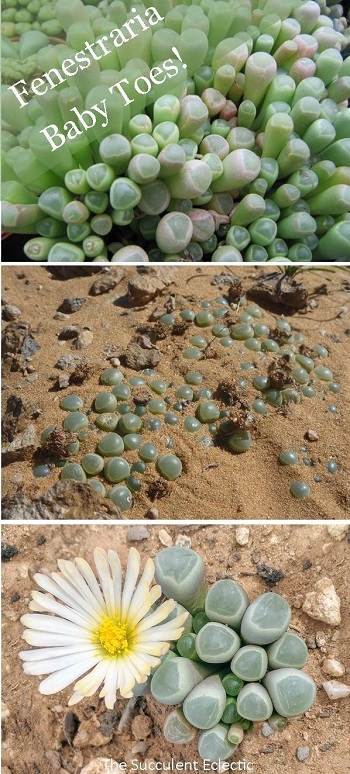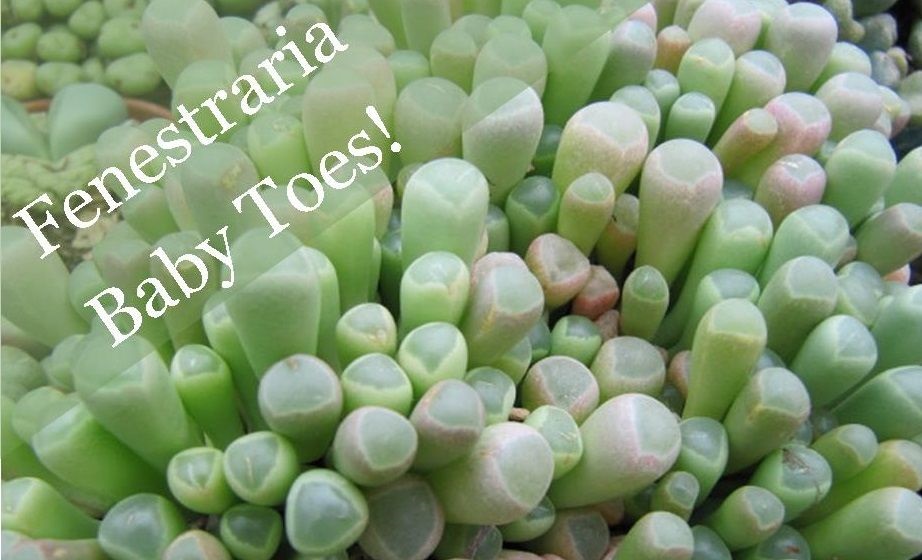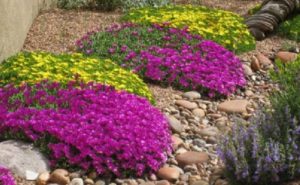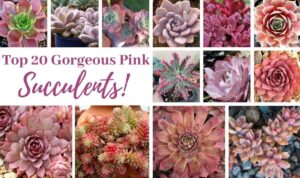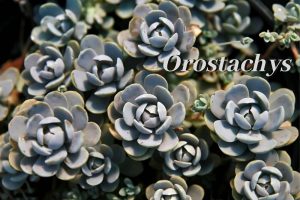Fenestraria, also known as baby toes, are among the cutest succulents known. And they are super easy to grow — unless! Do not let the adorable appearance and common name deceive you into pampering this plant, or you’re sure to kill it quickly. By all means, tickle your baby toes — just don’t baby this tough little succulent, or you’ll be sorry! Read on to learn all the mysteries of growing Fenestraria.
All About Growing Fenestraria Baby Toes
In this Post We'll Cover:
{Please note, some links in this post may be affiliate links to sites that pay me a small commission if you click on the link and make a purchase. This commission is at absolutely no cost to you. I only recommend products and companies that I have worked with and truly love! ~Kat}
Fenestraria
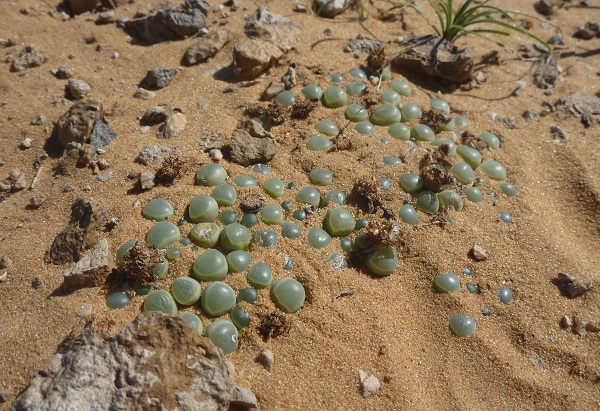
Fenestraria (Fenn-ess-TRAIR-ee-yah) is a monotypic genus — meaning it has just a single species. Fenestraria rhopalophylla, also known as baby toes or the baby toe succulent, is as tough as it is adorable. The name comes from the Latin word fenestra, meaning window. The name refers to the leaf windowsLeaf windows are specialized leaf structures specific to som... More at the tip of each leaf. In their native habitat of southeastern Namibia and South Africa, Fenestraria grow in full sun, buried deep in the desert sands with nothing but these translucent leaf window tips exposed. They look like a series of scattered glass marbles, don’t they? This remarkable adaptation enables the succulent to protect it’s leaves and stored water from the drying sun. Special cells allow sunlight to penetrate deep inside the plant where photosynthesisPhotosynthesis (FO-to-SIN-thuh-sis) is the process plants us... More takes place. All lithops living stones and some varieties of Haworthia have leaf windows and similar growth strategies.
Growing buried deep like this is the plants’ response to the extreme conditions in their native climate. You should not plant your Fenestraria this deep. But do keep in mind how tough these baby toes are, so their cute appearance and tender name doesn’t lead you to kill them with kindness.
Fenestraria form clusters of pudgy, peg-shaped leaves, tipped by leaf windowsLeaf windows are translucent structures on the outside of ... More. Essentially stemless, baby toes grow just 2.5″ (6.4 cm) tall in proper lighting. The roots are thick and fleshy, forming an extensive network to capture and make the most of any stray moisture in the soil.
Which is the ‘Real’ Baby Toes?
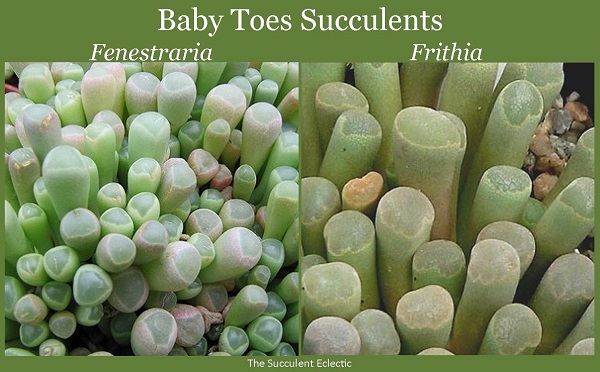
But which is the real baby toes?
Before we continue, let’s be sure we’re talking about the same baby toes succulent. Frithia is a different genus that looks remarkable like Fenestraria. So what’s the difference — and do you care? Both are evergreen, and just a couple inches tall. They look so much alike, but you’d better know the difference. Fenestraria are dormant in summer and actively growing and utilizing water in the winter. Frithia, commonly known as baby toes or fairy elephant feet (cute!), is dormant in the winter and actively growing in the summer. Each needs dry soil during their dormancy.
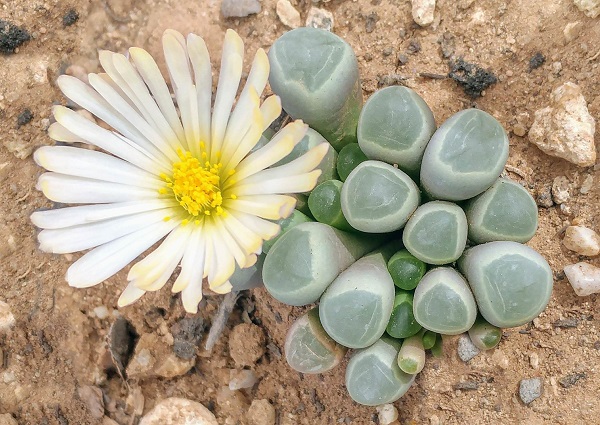
The easiest way to distinguish between Fenestratia and Frithia is their bloom color. Fenestraria have large, daisy-like blooms with long, slim petals in white or yellow. Frithia blooms are a bright, hot pink, though there are white blooming species. Frithia blooms are also shaped like a daisy, though the petals are shorter and wider. If your plant is not in bloom, take a good look at the leaf windows. Fenestraria leaf windows are far smoother, more round than those of Frithia, which are more ragged in their outline. Though Fenestraria are more popular, you can find Frithia available for sale.
Baby Toes Care
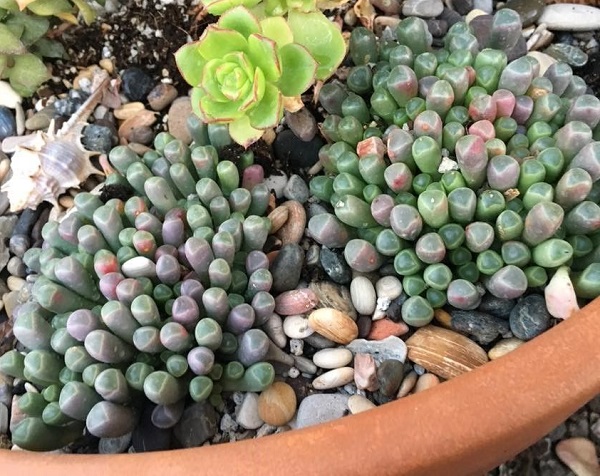
Water and Sunlight
Fenestraria baby toes are so easy to care for! Plant baby toes in fast-draining succulent soil. Give them a ton of sunshine and water rarely — only when the plant needs it. That’s it! 🙂 For the many (many) of you who have killed your baby toes with kindness — let’s go a little deeper.
Like all succulents, Fenestraria baby toes are well adapted to drought conditions. They store water for the plant’s later use. While they do need occasional watering, they are well-equipped to survive an absent gardener. It is too much water in the soil that is a threat to the plant’s survival. Because Fenestraria are more sensitive to over-watering than most succulents, let the plant demonstrate its need for water before you give it more. The leaves will become a bit wrinkled and slightly shrunken when the internal stores of water have been used. A good watering gives the plant what it needs and refills these stores. The “toes” swell and fill up plump again.
Over-watered Fenestraria split their leaves as they try to store more water than they can hold. This is a common cause of baby toes succulents dying. Fenestraria are dormant in the summer and should not be watered until they awake in the fall. If you follow the instructions above, you won’t have to watch the calendar to know when to withhold water and then when to resume. Jen White-Matthews’ healthy baby toes, above, display stress coloring — flushing light pink — due to growing in full sun. Thanks for the use of the photo, Jen!
Give Baby Toes Plenty of Light
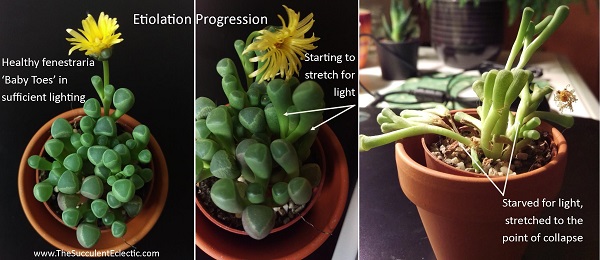
Fenestraria baby toes are supposed to be short and pudgy — no more than 2.5 inches tall (6.4 cm). Likely, most you’ve seen were growing a god bit taller than that. When succulents don’t get as much sunlight as they need, they stretch, reaching for more light. This is called etiolation, and it can be deadly, especially for Fenestraria. Baby toes do not have a stem that can grow longer, bringing the leaves closer to the light source. Instead, the leaves themselves must stretch. When they stretch too far, they collapse — there is no longer a functioning path for water and nutrients to flow, and that part of the plant dies.
Most sites tell you Fenestraria can be grown indoors. While this is technically true, it assumes you have large windows with an unobstructed southern exposure that delivers a minimum of 6 hours of direct light each day. If you don’t, plan to grow your baby toes outdoors in direct sun for at least 5-6 hours a day or they will stretch. While they can tolerate a light touch of frost, plan to overwinter your baby toes indoors with a grow light for succulents — unless you’re in a frost-free climate.
PropagatingPropagating (PRAH-puh-gate-ing) a plant is to grow another p... Fenestraria
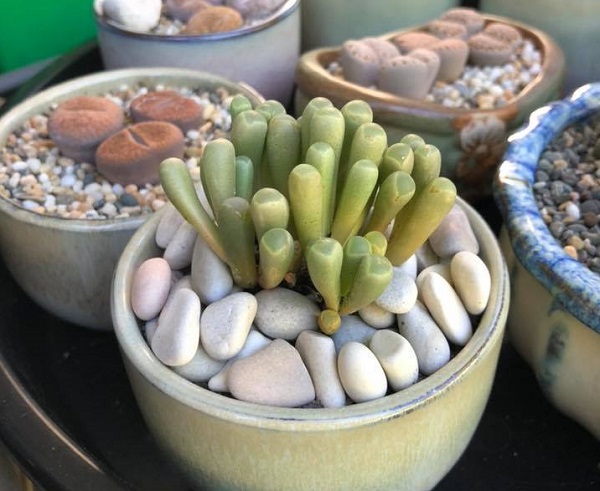
photo credit Dr. Megan Yap
Like lithops living stones, Fenestraria are members of the Aizoacaea family. Succulent members of this family that resemble stones were formerly classified members of the Mesembryanthemaceae family, and are still called mesembs. Because baby toes, like other mesembs, have no true stems, the only way to propagate these little charmers is via succulent division or by sowing seeds. Fenestraria form offsetsSucculent offsets are the baby succulents that form at the b... that can be divided from the main plant to be potted separately. In the photo above, can you see that the baby toes near the front right can likely be divided from those front left and both sets from those in the back? Because they are slow to grow from seed, division is the best way to propagate baby toes — at least for those impatient sorts like me! 🙂 However, the seeds are tough and long-lived, so you can readily find viable Fenestraria seeds from reputable sellers.
The photo above, by Dr. Megan Yap, shows off the Fenestraria well, making great use of a soil top dressing. Dr. Yap is a noted paediatrician and writes Kids Health Guru. How fitting that her baby toes are thriving!
Is Fenestraria Toxic to Pets?

Fenestraria baby toes are completely safe to grow around pets and small children!
This symbol denotes pet-safe succulents. For more information about succulents and pets, just click on this image anywhere on this site.
Shopping for Fenestraria Baby Toes
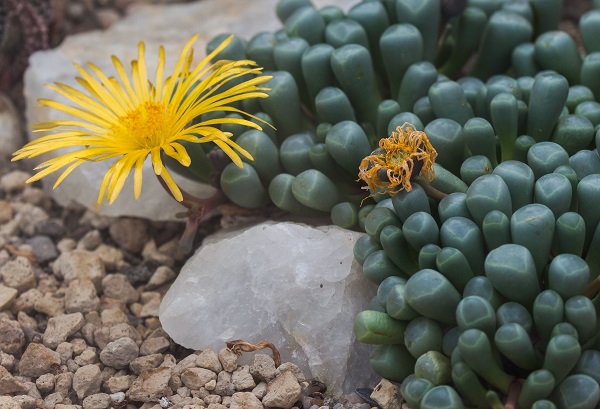
I’m not sure why, but I seldom find Fenestraria plants at my local nursery or box store. But they’re easy to find online — just be sure to select a reputable succulent vendor. Mountain Crest Gardens, Leaf & Clay and The Succulent Source all offer baby toes as potted plants. Each of these companies consistently delivers top quality plants. You’ll also find both Fenestraria seeds and growing plants available from good vendors on Amazon. I hope you’ll choose to grow this charming little plant!
Just be sure never to baby your baby toes!
Please subscribe to The Succulent Eclectic. You’ll receive my FREE e-course, 7 Steps to Succulent Success! and really make my day! Thanks!
P.P.S. Why not join my Facebook Group for succulent lovers? We talk about succulent care, propagation, succulent identification, and design. It’s a warm and welcoming group that would love to meet you!
